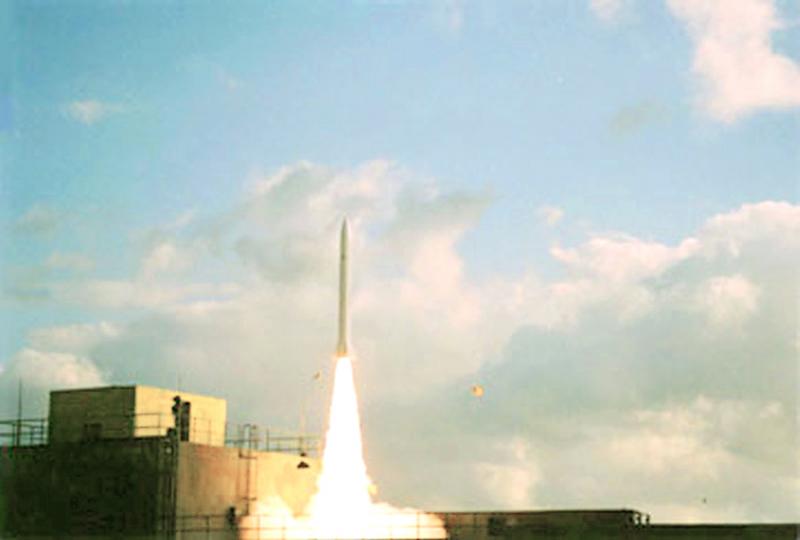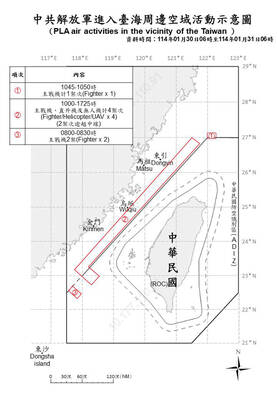The Chungshan Institute of Science and Technology yesterday said that alleged fraud in the production of indigenous Tien Kung missiles (Skybow, 天弓) would not affect national security, after local media reported that local contractors had used poor quality Chinese-sourced materials.
Chinese-language Mirror Media magazine yesterday reported that local contractors involved in the production of Tien Kung missiles had used inferior-quality silicon controlled rectifiers (SCR) sourced from China, severely affecting missile capabilities.
The Tien Kung family of missiles, especially Tien Kung-III, is expected to become the nation’s main anti-aircraft platform, and if they were unable to launch as a result of poor components, it would heavily compromise national security, the magazine said.

Photo: Yu Jui-jen, Taipei Times
The institute said that it had discovered the attempts to pass off inferior goods for original equipment in March last year.
It refuted the magazine’s report that the incident has affected national security, saying that it has implemented existing measures that would minimize the incident’s effect on arms production and other projects.
The institute said that it had reached out to US-based Semitronics Corp, the only company capable of manufacturing SCRs used in the Skybow missiles to military specifications, and that both sides agreed to implement measures that would facilitate the institute’s efforts to confirm that the products originated from Semitronics.
The managers of contractors Onsen Taiwan Cosmetics Corp (昂神國際) and Burnaby Light Technology Corp (勳章科技) — Chen Ching-mao (陳清茂), 55, and his sons, Chen Yen-chang (陳彥璋), 31, Chen Yen-hsun (陳彥勳), 28 — were indicted on fraud and forgery charges last year.
The Chens had first delivered to the institute 84 Semitronics-manufactured SCRs, but its later deliveries were inferior stock from China, prosecutor reports showed.
The Chens falsified device serial numbers and import papers to skim money off the project, making NT$100 million (US$3.59 million) from the deals, the reports said.
“We welcome all business owners to invest in the national defense sector and be a part of building an autonomous national defense industry,” the institute said, adding that it would tighten oversight and management measures to ensure that all projects produce high-quality results on time.
The Legislative Yuan on Jan. 11 approved the Government’s Special Budget for Procurements to Enhance Combat Capability for the Navy and the Air Force (中央政府海空戰力提昇計畫採購特別預算案), totaling NT$236.96 billion.
Under the law, the Ministry of National Defense was expected to draft regulations to prevent contractors from using Chinese goods and to brief the legislature of said regulations within a month of the budget’s approval.
A separate addendum, citing how 19.8 percent of goods provided by contractors in 2020 were flawed, demanded that the ministry and the institute implement quality-control measures for their contractors.
As of press time last night, the ministry had not delivered the draft to the legislature.
The institute admitted that the SCRs were used in other missiles outside of the Tien Kung family of missiles, but declined to name the type of missiles affected, citing classified data.
Allegations that the Taiwanese military had been “unable” to track Chinese People’s Liberation Army ship and plane movements in 2020 were baseless rumors, the institute added.
The institute had discovered attempts to pass off inferior-quality SCRs as Semitronics-manufactured SCRs during quality control, adding that the components had never been installed in the missiles, said a source who spoke on condition of anonymity.
Additional reporting by Yu Jui-jen, Wu Su-wei and Aaron Tu

Taiwanese actress Barbie Hsu (徐熙媛) has died of pneumonia at the age of 48 while on a trip to Japan, where she contracted influenza during the Lunar New Year holiday, her sister confirmed today through an agent. "Our whole family came to Japan for a trip, and my dearest and most kindhearted sister Barbie Hsu died of influenza-induced pneumonia and unfortunately left us," Hsu's sister and talk show hostess Dee Hsu (徐熙娣) said. "I was grateful to be her sister in this life and that we got to care for and spend time with each other. I will always be grateful to

UNITED: The premier said Trump’s tariff comments provided a great opportunity for the private and public sectors to come together to maintain the nation’s chip advantage The government is considering ways to assist the nation’s semiconductor industry or hosting collaborative projects with the private sector after US President Donald Trump threatened to impose a 100 percent tariff on chips exported to the US, Premier Cho Jung-tai (卓榮泰) said yesterday. Trump on Monday told Republican members of the US Congress about plans to impose sweeping tariffs on semiconductors, steel, aluminum, copper and pharmaceuticals “in the very near future.” “It’s time for the United States to return to the system that made us richer and more powerful than ever before,” Trump said at the Republican Issues Conference in Miami, Florida. “They

REMINDER: Of the 6.78 million doses of flu vaccine Taiwan purchased for this flu season, about 200,000 are still available, an official said, following Big S’ death As news broke of the death of Taiwanese actress and singer Barbie Hsu (徐熙媛), also known as Big S (大S), from severe flu complications, the Centers for Disease Control (CDC) and doctors yesterday urged people at high risk to get vaccinated and be alert to signs of severe illness. Hsu’s family yesterday confirmed that the actress died on a family holiday in Japan due to pneumonia during the Lunar New Year holiday. CDC Deputy Director-General Tseng Shu-hui (曾淑慧) told an impromptu news conference that hospital visits for flu-like illnesses from Jan. 19 to Jan. 25 reached 162,352 — the highest

TAIWAN DEFENSE: The initiative would involve integrating various systems in a fast-paced manner through the use of common software to obstruct a Chinese invasion The first tranche of the US Navy’s “Replicator” initiative aimed at obstructing a Chinese invasion of Taiwan would be ready by August, a US Naval Institute (USNI) News report on Tuesday said. The initiative is part of a larger defense strategy for Taiwan, and would involve launching thousands of uncrewed submarines, surface vessels and aerial vehicles around Taiwan to buy the nation and its partners time to assemble a response. The plan was first made public by the Washington Post in June last year, when it cited comments by US Indo-Pacific Commander Admiral Samuel Paparo on the sidelines of the Shangri-La Dialogue